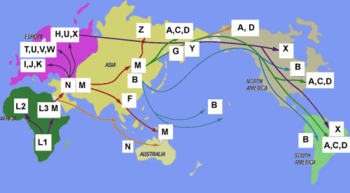- Human mitochondrial DNA haplogroup
-
 Hypothesized world map of human migrations, with the North Pole at center. Africa, harboring the start of the migration, is at the top left and South America at the far right. Migration patterns are based on studies of mitochondrial (matrilinear) DNA. Letters represent haplogroups while colors and numbers represent thousands of years before present.
Hypothesized world map of human migrations, with the North Pole at center. Africa, harboring the start of the migration, is at the top left and South America at the far right. Migration patterns are based on studies of mitochondrial (matrilinear) DNA. Letters represent haplogroups while colors and numbers represent thousands of years before present.
In human genetics, a human mitochondrial DNA haplogroup is a haplogroup defined by differences in human mitochondrial DNA. Haplogroups are used to represent the major branch points on the mitochondrial phylogenetic tree. Understanding the evolutionary path of the female lineage has helped population geneticists trace the matrilineal inheritance of modern humans back to human origins in Africa and the subsequent spread across the globe.
The letter names of the haplogroups run from A to Z. As haplogroups were named in the order of their discovery, they do not reflect the actual genetic relationships.
The woman at the root of all these groups is the matrilineal most recent common ancestor (MRCA) for all currently living humans. She is commonly called Mitochondrial Eve.
Part of a series on
Genetic genealogyConcepts - Population genetics
- Haplogroup/ Haplotype
- Most recent common ancestor
- Human mitochondrial DNA haplogroups
- Human Y-chromosome DNA haplogroups
- Genomics
Other - Y-chromosome haplogroups by populations
- Genealogical DNA test
- Personal genomics
- Genographic Project
Contents
Evolutionary relationship
Lineage Perspective
This phylogenetic tree is based on the Van Oven 2009 tree[1] and subsequent published research.
Table Perspective
Evolutionary tree of Human mitochondrial DNA (mtDNA) haplogroups
Mitochondrial Eve (L) L0 L1-6 L1 L2 L3 L4 L5 L6 M N CZ D E G Q A S R I W X Y C Z B F R0 pre-JT P U HV JT K H V J T Chronological development of haplogroups
European haplogroups
Bryan Sykes had claimed there were seven major mitochondrial lineages for modern Europeans but others now put the number at 10-12. These additional "daughters" generally include haplogroups I, M and W. A recent paper re-mapped European haplogroups as H, J, K, N1, T, U4, U5, V, X and W.[2]
Haplogroup Possible time of origin Possible place of origin Highest frequencies N 75,000 years ago North-East Africa R 70,000 years ago South-West Asia U 60,000 years ago North-East Africa or South-West Asia pre-JT 55,000 years ago Middle East JT 50,000 years ago Middle East U5 50,000 years ago Western Asia U6 50,000 years ago North Africa U8 50,000 years ago Western Asia pre-HV 50,000 years ago Near East J 45,000 years ago Near East or Caucasus HV 40,000 years ago Near East H over 35,000 years ago Near East or Southern Europe X over 30,000 years ago north-east Europe U5a1 30,000 years ago Europe I 30,000 years ago Caucasus or north-east Europe J1a 27,000 years ago Near East W 25,000 years ago north-east Europe or north-west Asia U4 25,000 years ago Central Asia J1b 23,000 years ago Near East T 17,000 years ago Mesopotamia K 16,000 years ago Near East V 15,000 years ago Iberia and moved to Scandavia H1b 13,000 years ago Europe K1 12,000 years ago Near East H3 10,000 years ago Western Europe African haplogroups
Asian haplogroups
See also
- Genealogy
- The Seven Daughters of Eve
- Genealogical DNA test
- Genetic Genealogy
- MtDna haplogroups by populations
- Human Y-chromosome DNA haplogroups
- Genetics
- Human mitochondrial molecular clock
- Cambridge Reference Sequence
- * (haplogroup)
- Human mitochondrial genetics
- Hypervariable region
- Molecular phylogeny
- Population Genetics
- Bio-Informatics
References
- ^ van Oven M, Kayser M (February 2009). "Updated comprehensive phylogenetic tree of global human mitochondrial DNA variation". Human Mutation 30 (2): E386–94. doi:10.1002/humu.20921. PMID 18853457.
- ^ "Disuniting Uniformity: A Pied Cladistic Canvas of mtDNA haplogroup H in Eurasia"
External links
- Mitochondrial Phylogenetic Trees
- Ian Logan's Mitochondrial DNA Site
- Mannis van Oven's PhyloTree.org
- Tamm E, Kivisild T, Reidla M, et al. (2007). Carter, Dee. ed. "Beringian standstill and spread of Native American founders". PloS One 2 (9): e829. doi:10.1371/journal.pone.0000829. PMC 1952074. PMID 17786201. http://www.pubmedcentral.nih.gov/articlerender.fcgi?tool=pmcentrez&artid=1952074.
- Mitochondrial haplogroup skeleton
- Vincent Macaulay's Mitochondrial haplogroup motifs
- Cambridge DNA's An mtDNA view of the peopling of the world by Homo sapiens
- John S. Walden's Map of macro-haplogroup N
- List of mtDNA haplogroup projects
- mtDNA haplogroup determination
- Journal Articles
- Sharma S, Saha A, Rai E, Bhat A, Bamezai R (2005). "Human mtDNA hypervariable regions, HVR I and II, hint at deep common maternal founder and subsequent maternal gene flow in Indian population groups". Journal of Human Genetics 50 (10): 497–506. doi:10.1007/s10038-005-0284-2. PMID 16205836.
- Behar DM, Metspalu E, Kivisild T, et al. (March 2006). "The matrilineal ancestry of Ashkenazi Jewry: portrait of a recent founder event". American Journal of Human Genetics 78 (3): 487–97. doi:10.1086/500307. PMC 1380291. PMID 16404693. http://www.ftdna.com/pdf/43026_doron.pdf.
Categories:- Human mtDNA haplogroups
- Genetic genealogy
- Recent single origin hypothesis
Wikimedia Foundation. 2010.

